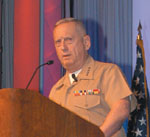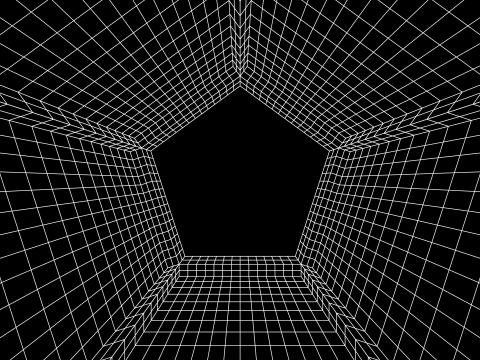U.S. Army Ponders Cyber Operations
 |
Gen. Carter F. Ham, USA, commanding general, U.S. Army Europe and the Seventh Army, explains that the Army’s signals community is at the center of a major change within the service as it begins to leverage its legacy information networks and cyberspace to enhance its command and control (C2) capabilities. Communications personnel, he notes, will be vital to building and maintaining the systems on which the Army’s full-spectrum operations rely. |
Modern communications and sensor systems have greatly increased the speed and effectiveness of maneuver warfare and have empowered units at the edge by providing them with greater situational awareness. But these benefits have a price—lack of interoperability caused by disparate equipment and vulnerability to external threats ranging from jamming to cyberattacks.
These issues were on the minds of top U.S. Army officers and U.S. Defense Department officials meeting at AFCEA International’s LandWarNet 2009 conference in
The Army must begin to leverage its existing information networks and cyberspace to enable its C2, explained Gen. Carter F. Ham,
Sharing data between joint and coalition forces is another key to network-enabled operations. The general cited the Berlin Wall as an example of how different nations approach information sharing. The wall represented the Soviet Union’s attempt to control the flow of information and people while the
Barriers to information sharing must come down while finding new ways to operate safely when sharing information must be established, Gen. Ham stated. Teamwork and coordination are necessary regardless of the service, department or nation. The general urged service members to consider how to break down barriers and develop networks that can share C2 information.
Brig. Gen. Steven W. Smith, USA, chief cyber officer, Army Chief Information Officer (CIO)/G-6, noted that the Army is participating in several key initiatives such as the Comprehensive National Cyber Initiative (CNCI), the Defense Department Information Assurance Campaign Plan (DOD IACP), the standing up of the U.S. Cyber Command (CYBERCOM) and operation Gladiator Phoenix. Regarding the Army’s direct role in cyberspace, the general emphasized that the service’s mission is to integrate efforts across the Army staff to provide policy, oversight and guidance for any cyberspace operations.
Operation Gladiator Phoenix will be a major exercise in which 71 percent of the activity will be oriented toward network defense. The remaining 30 percent of the event’s efforts will focus on sustaining exploitation and cyberattack capabilities. The goal of the DOD IACP is to help commands prioritize how they spend money on information assurance. The general adds that the effort has some 20 end-states. Several of these goals are accountability from the top, layered network defense, strong external perimeters, the capability to keep secrets and developing partnerships with industry.
 |
Lt. Gen. Jeffrey A. Sorenson, USA, Chief Information Officer/G-6, explains that the Army is establishing fixed network hubs around the world to support its operations. These regional hub nodes will be designed to enhance connectivity between units in theaters across the globe. |
To support network operations, Gen. Sorenson described a recent experiment in which an Army unit deployed overseas. The goal of the test was to maintain the unit’s network connectivity at the same level throughout the deployment as it enjoyed in its home base. The general noted that the only time the unit did not have connectivity was when its troops were flown overseas.
Gen. James N. Mattis, USMC, then NATO supreme allied commander transformation, and commander, U.S. Joint Forces Command, discussed the technological and cultural aspects of C2 as they applied to the military. The general said he is passionate about C2, but added that it is a capability that extends beyond technology. “No matter how brave your soldiers are, they’re going to catch RPGs [rocket-propelled grenades] in the chest if you don’t get C2 correctly,” he cautioned.
The general noted that decentralized command speeds action by allowing field officers to exercise their initiative. But he added that training and education are key to achieving this goal.
Technological improvements will change how commanders receive orders, Gen. Mattis predicted. Instead of long, detailed orders that consume bandwidth, battlefield leaders increasingly will be called upon to use their own initiative to achieve operational goals.
Likewise, the general explained, a network is more than just technology. The network—both the hardware and the human—must support troops at the tactical edge. “Agility is not solely technological,” he said.
Noncommissioned officers and officers must be able to take advantage of opportunities. Subordinates must exercise initiative to carry out commanders’ intent, he said.
 |
Gen. James N. Mattis, USMC, then NATO supreme allied commander transformation, and commander U.S. Joint Forces Command, points out that although C2 is often viewed in terms of technology, a vital human component remains that must be nurtured and maintained. The general described C2 as a leader-centric practice based on the trust between commanders and their subordinates. |
The Army’s command, control, communications, computers, intelligence, surveillance and reconnaissance (C4ISR) road map was another key topic of discussion. Col. William C. Hoppe,
Among the major Army communications systems discussed, the colonel highlighted the enhanced position location radio system (EPLRS) and the single channel ground and airborne radio system (SINCGARS). EPLRS provides voice and high-speed data throughput for mounted and dismounted warfighters. In the near future, EPLRS systems will be integrated with defense advanced Global Positioning System (GPS) receiver (DAGR) devices. Col. Hoppe notes that this application is not necessarily for position reporting but for network synchronization. The Defense Advanced Research Projects Agency (DARPA) and the Defense Information Systems Agency (DISA) also are examining the potential for EPLRS as a part of a dynamic spectrum access technology that would route transmissions to empty areas of spectrum.
SINCGARS, which is used to move voice and data communications to the lowest echelons of the force, is being improved with a new radio. Col. Hoppe noted that a new contract has been awarded to an industry team consisting of ITT and Thales. The SINCGARS G radio combines circuit boards from ITT and elements from Thales’ Joint Tactical Radio System (JTRS) Enhanced Multiband (JEM) radio. He explained that this radio will provide warfighters with capabilities similar to the JTRS.
Col. Hoppe also discussed increments one, two and three of the WIN-T program. Major parts of increment one are being deployed, and increments two and three will create an integrated transmission system with terrestrial and over-the-horizon capabilities. The service also is pushing increment two down to the company level. An important aspect of increment two is a satellite communications application that can reconnect broken terrestrial communications links automatically.
Army Vice Chief of Staff Gen. Peter W. Chiarelli,
If the sharing of battlefield information had not been managed properly, it would have crippled the Army’s operational efforts, Gen. Chiarelli shared. However, he credits the success of systems such as the Force 21 Battle Command Brigade and Below (FBCB2) and the Command Post of the Future (CPOF) for providing soldiers with increased situational awareness. The tactical ground reporting system (TIGR) is making its way to troops in the field. It is a virtual notebook designed to provide soldiers and commanders with data and information to make better decisions.
Despite these developments, however, there have been challenges. The general noted that communications personnel resisted the development and deployment of C2 systems such as FBCB2, CPOF and TIGR. He added that the Army also takes a cookie-cutter approach to computer security and warned that it is individual soldiers who suffer from bad decisions and lack of foresight about the implications of some policies.
An example of unintended consequences is the pressure that excessive requirements place on new technologies. The general said that procurement processes are having difficulty keeping pace with technological change and that many Army systems have redundant or non-interoperable software, which causes communications issues.
Security policies also can stifle the development of new communications systems for warfighters. Citing the Apple iPhone and the great variety of downloadable applications available for the device, Gen. Chiarelli asked why the Army cannot deliver a similar capability. He speculated that such a system would allow a soldier in combat to access live video from an overhead unmanned aerial vehicle or agricultural data for soldiers on humanitarian missions. The general stressed that he would like to see a method that allowed Army personnel to develop applications for their handheld devices.
Another major topic of discussion was the Army’s Signal Cyberspace Operations Campaign Plan. According to Russell Fenton of the Concepts, Requirements and Doctrine Division at the
One facet of the campaign plan is support of enduring CND capabilities. Fenton noted that the Army is developing a new cyber military occupational specialty, or MOS, for warrant officers that would focus on network operations, information security and information protection technology. However, he said that this new skills set would progress in levels of expertise over a period of years to produce experienced and mature cyberwarriors.
The



Comments